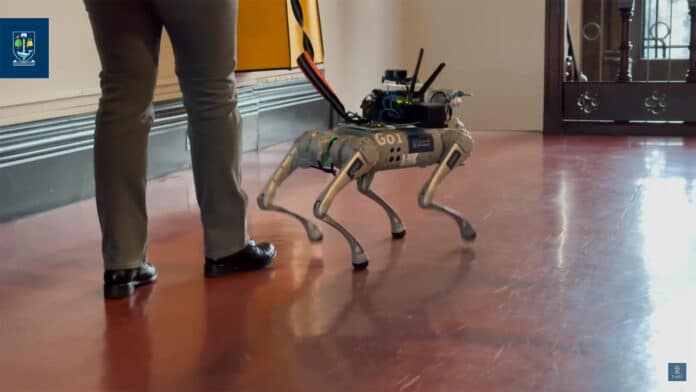A new chatty robot guide dogs – currently in development at a Scottish university – could soon help blind and partially sighted people find their way around indoor spaces.
Experts from the University of Glasgow have partnered with industry and charities to develop an AI-powered four-legged robot called RoboGuide. The robot aims to help visually impaired people move more independently through museums, shopping centers, hospitals, and other public places in the future.
The RoboGuide prototype uses a variety of cutting-edge technologies to help overcome challenges preventing robots from being more widely used in assisting blind and partially sighted individuals.
The ultimate goal is to bring a more complete version of this technology to the market in the future to support the 2.2 billion people worldwide, including two million in the UK, who live with sight loss.
“Our assistive technology project for the visually impaired embodies innovation, fostering inclusivity,” said Prof Muhammad Imran, co-investigator on the project. “In Glasgow, we’re pioneering world-changing technologies that hold the potential to transform lives and reshape societal norms. This achievement was made possible through collaboration with industry and charity partners and co-creating the design with the invaluable input of end users.”
“Assistive technologies like the RoboGuide have the potential to provide blind and partially sighted people with more independence in their daily lives in the years to come,” said Dr Olaoluwa Popoola, the RoboGuide project’s principal investigator. “One significant drawback of many current four-legged, two-legged and wheeled robots is that the technology which allows them to find their way around can limit their usefulness as assistants for the visually impaired.”
“Robots that use GPS to navigate, for example, can perform well outdoors but often struggle in indoor settings, where signal coverage can weaken. Others, which use cameras to ‘see,’ are limited by line of sight, which makes it harder for them to safely guide people around objects or around bends.”
The RoboGuide system integrates various sensors to accurately map and assess its surroundings and interpret the data in real time to avoid obstacles. Developed software on Unitree Go1 quadruped enables the robot to acquire knowledge of optimal routes between destinations. It also incorporates large language model technology that allows it to understand and respond to questions and comments from users.
The Forth Valley Sensory Centre (FVSC) Trust and the Royal National Institute of Blind People (RNIB) Scotland are supporting the development of RoboGuide. During the test the RoboGuide was recently tested in December with volunteers from FVSC and RNIB at the Hunterian, Scotland’s oldest museum. The RoboGuide helped volunteers navigate the museum’s first floor and provided interactive spoken guidance on six exhibits.
“Ultimately, our aim is to develop a complete system that can be adapted for use with robots of all shapes and sizes to help blind and partially sighted people in a wide range of indoor situations. We hope that we can create a robust commercial product that can support the visually impaired wherever they might want extra help,” said Dr Wasim Ahmad of the James Watt School of Engineering, a co-investigator on the project.
Real guide dogs are expensive and time-consuming to train, and not all of them can work with visually impaired people. Robotic guide dogs, on the other hand, can offer many benefits, such as lower costs, higher efficiency, and wider availability.
This innovation can transform the way visually impaired people receive assistance, overcoming the limitations of traditional guide dogs and enabling more freedom and mobility.
